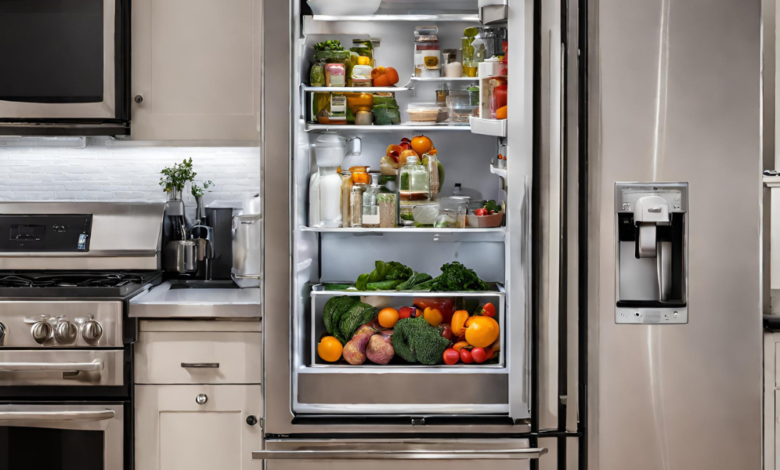Mastering Refrigerator Organization: A Comprehensive Guide for Efficiency

The refrigerator is the heart of any kitchen, and its organization plays a crucial role in maintaining freshness, preventing food waste, and optimizing energy efficiency. In this in-depth guide, we’ll explore creative and strategic ways to organize your refrigerator for maximum efficiency.
Why Efficient Refrigerator Organization Matters
A well-organized refrigerator not only makes it easier to find and access items but also helps in maintaining optimal temperatures, reducing energy consumption, and extending the shelf life of perishables. By implementing thoughtful organizational strategies, you can create a harmonious system that benefits both your daily routines and the environment.
Understanding Refrigerator Zones
Before diving into specific organization tips, it’s essential to understand the different temperature zones within your refrigerator.
Main Zones
- Upper Shelves (Warmer Zone): This area is ideal for items that don’t require extremely cold temperatures, such as leftovers, drinks, and ready-to-eat snacks.
- Lower Shelves (Colder Zone): Reserved for perishables like raw meats, dairy, and eggs, this section benefits from the coldest temperatures in the refrigerator.
- Crisper Drawers: Designed to maintain higher humidity levels, these drawers are perfect for storing fruits and vegetables.
- Door Shelves (Warmer Zone): Best suited for condiments, beverages, and other items with a longer shelf life.
Creative Refrigerator Organization Tips
1. Zone-Based Organization
Divide your refrigerator into specific zones based on temperature, as mentioned above. Assign designated shelves and drawers for different categories to streamline the organization process.
2. Use Clear Storage Containers
Invest in transparent containers for storing leftovers, fruits, and snacks. This allows you to see the contents without opening the container, reducing the time the door is open and helping to maintain consistent temperatures.
3. Labeling System
Implement a labeling system using removable labels or a whiteboard marker. Label containers with dates to track the freshness of leftovers and perishables.
4. Create a Beverage Station
Designate a specific area for beverages, including a bin for canned drinks and a shelf for larger bottles. This minimizes the time the refrigerator door is open, preventing unnecessary temperature fluctuations.
Maximizing Upper Shelves
5. Utilize Lazy Susans
Lazy Susans are rotating trays that make accessing items on the upper shelves easier. They are particularly useful for condiments, sauces, and smaller items that tend to get lost in the back.
6. Store Leftovers in Clear Containers
Opt for stackable, clear containers for leftovers. This not only makes it easy to identify what’s inside but also maximizes space by allowing efficient stacking.
7. Organize by Frequency of Use
Place frequently used items at eye level for easy access. This reduces the need to search through the refrigerator, minimizing the time the door is open.
Optimizing Lower Shelves
8. Use Fridge Mats
Fridge mats absorb excess moisture, preventing bacterial growth and extending the life of produce. They also make cleaning spills and messes a breeze.
9. Invest in Adjustable Shelves
If possible, invest in a refrigerator with adjustable shelves. This allows you to customize the space based on the size of items you need to store.
10. Keep Raw Meats Separate
To prevent cross-contamination, store raw meats in sealed containers or on trays on the lower shelves. This ensures that any potential drips do not come into contact with other food items.
Mastering Crisper Drawers
11. Organize by Humidity Level
Most crisper drawers have adjustable humidity settings. Store fruits that release ethylene gas, such as apples and pears, in one drawer with low humidity. Vegetables, which prefer higher humidity, can be stored in the other drawer.
12. Use Produce Storage Containers
Consider using specialized produce storage containers designed to maintain optimal humidity levels for different types of fruits and vegetables.
13. Rotate Produce Regularly
To prevent the buildup of moisture and potential mold, rotate your produce regularly. Use older items first and place fresh produce at the back to ensure an even rotation.
Mastering Door Shelves
14. Organize by Temperature Sensitivity
Place items on the door shelves based on their temperature sensitivity. Keep dairy, eggs, and condiments that can withstand warmer temperatures here.
15. Use Door Bins for Small Items
Door bins are perfect for storing small items like butter, jars of olives, or small condiments. Utilize this space for items that can withstand the warmer temperatures found in the door.
16. Secure Tall Bottles with a Rack
If your refrigerator door has ample height, use a rack to secure tall bottles. This prevents them from toppling over when the door is opened and closed.
Additional Tips for Efficiency
17. Regularly Check and Adjust Temperature Settings
Monitor the temperature of your refrigerator regularly and adjust settings as needed. This ensures that your food stays fresh while minimizing energy consumption.
18. Keep an Inventory List
Maintain a running inventory list on the refrigerator door to keep track of what you have. This prevents overbuying and helps you use items before they expire.
19. Practice the “First In, First Out” Rule
When restocking groceries, place newer items behind older ones. This encourages you to use older items first, reducing the risk of food waste.
20. Clean and Defrost Regularly
A clean refrigerator operates more efficiently. Regularly clean spills, wipe down shelves, and defrost the freezer to maintain optimal performance.
Conclusion
By implementing these creative and strategic organization tips, you can transform your refrigerator into a well-ordered and efficient space. Not only will this save you time and reduce food waste, but it will also contribute to a more sustainable and environmentally friendly kitchen. Mastering refrigerator organization is a small yet impactful step towards a more organized and energy-efficient home.






